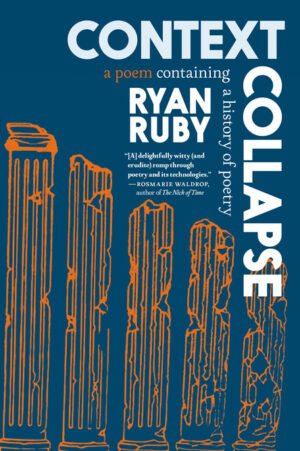Context Collapse: A Poem Containing a History of Poetry
by Ryan Ruby
reviewed by Ancci
Ryan Ruby’s Context Collapse: A Poem Containing a History of Poetry situates itself within the tradition of ambitious, genre-blurring works while simultaneously questioning the very foundations of the medium it employs. Spanning nearly three millennia—from the oral epics of Bronze Age Greece to the digital torrents of Silicon Valley—Ruby’s verse-essay charts the evolution of Western poetry through its changing media technologies and socioeconomic contexts. Sweeping and experimental, the result is a work of impressive intellectual weight that illuminates how the material conditions of poetry’s production and reception—its context—have shaped form and function across ages.
Ruby does without, or “deprioritizes,” basic attributes of poetry like “troping” and “image formation” in favor of “rhetoric” and “argumentation.” In “Razo,” an introductory essay, he anticipates our objections and reservations: “For those who suspect that, in writing it, what I have done is simply chopped up a preexisting prose essay into metered lines, I encourage you to perform the experiment of ‘restoring’ its lines to prose and read the results.” This scholarly bent, however, comes at the expense of poetic vitality. While Context Collapse succeeds as a meticulously researched work, its execution in verse has as its priorities academic rigor and argumentative clarity over the nuance, cadence, and figurative distinction we typically associate with poetry, and is thus less resonant as a poetic artifact.
The tension between Ruby’s scholarly ambition and poetic execution is a natural consequence of his core methodological commitment: to treat poetry “as a media technology—as the quintessential and perhaps even original media technology—and only secondarily as a series of forms and genres.” Drawing on figures like Friedrich Kittler and the oral-formulaic theories of Milman Parry and Albert Lord, Ruby maintains that the “technologically and economically mediated relationship between poet and audience—what I call here ‘context’—is the major determinant of poetic form, as it changes over time.” This theory emphasizes the material conditions, communication networks, and socioeconomic structures that undergird poetic production throughout history.
Ruby revives the dormant genre of the verse-essay with a “mock-academic” tone, comparing his work to Alexander Pope’s Dunciad. This historical survey plunges in medias res: he begins in Bronze Age Greece where the “aoidos,” the bard or oral poet, commands influence over the literary domain. Here, the “context” is both immediate and physical and the constraints material: “At first, the question of the audience / Is quite simple: where should it be seated.” The characteristics of Homeric epics like meter, Ruby argues, were primarily functional, mnemonic, and performance technologies. In this world, where the oral poet and audience are “cosensible,” the notion of a distinct author is a “category error,” particularly because the poet is a mere conduit for the divine inspiration.
The survey continues through the invention of the alphabet and writing, which altered the poet-audience co-sensibility. Eventually, this technological advance, enabling preservation and wider circulation, Ruby claims, led to a sophisticated media environment where poetry faced novel pressures from mass markets and new technologies. High modernism, with its characteristic difficulty and allusiveness, becomes legible in Ruby’s framework as a strategic retreat. Ruby notes how critics like T. S. Eliot justified modernism’s obsession with complexity as necessary for expressing a complex civilization while, simultaneously, the economics of patronage and deluxe editions turned the difficult poem into a sort of collectible. The verse-footnote on this claim reads:
Literary modernism revived
some of the features associated
with premodern cultural economies,
but as Lawrence Rainey shows, patronage,
as it then existed, constituted
a circuit within the culture market
rather than a system in its own right.
Ruby’s historical analysis continues into our contemporary epoch and the age-old, stable theories for poetic communication disintegrate further under the sweeping pressures of the internet, social media, and an information economy that whelms the mind. He posits the contemporary poet’s function as akin to research and development: an “early adopter of new media, the canary in the coal mine where technology, economics, and language meet.” It is an interesting diagnosis of poetry’s precarious position, contending with such platforms that fragment attention and flatten context. Yet, it is precisely here, in the analysis of contemporary moment, that the limitations of Context Collapse as a poetic artifact feel most pronounced.
When Ruby writes about poetry being “pushed further to the margins / of culture,” his verse remains academic and measured. Although Ruby occasionally disrupts his pentameter with multilingual elements to exemplify his point—for instance, the Russian words “трудный, затрудненный, заторможенный” (“difficult, constrained, inhibited”) describe modernism’s difficulty—such moments are isolated instances. In a book that takes experimentation as its skin and veins, we expect formal disruption to mirror the digital fragmentation of our attention. Ruby’s narrative monotony, however, undermines that expectation. Taken merely as an historical document and argument, Context Collapse is formidable and stands as a work of significant intellectual achievement. However, despite Ruby’s attempt at justifying the shortcomings, it leaves the reader intellectually stimulated but aesthetically wanting more.
Published on July 15, 2025

